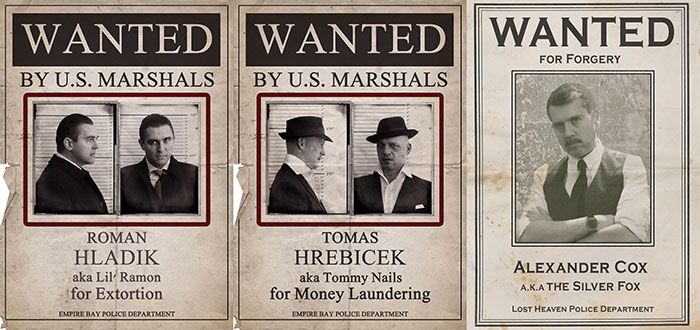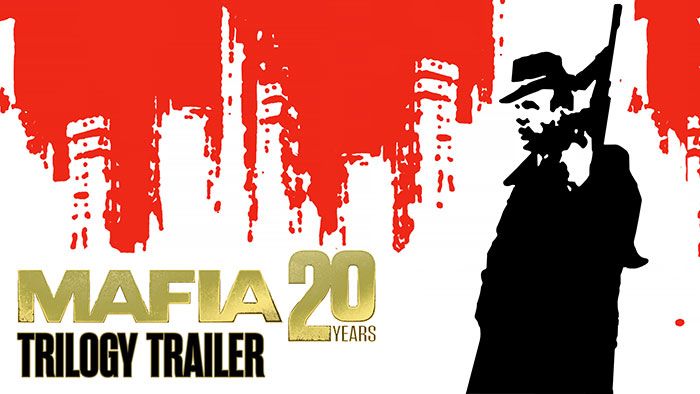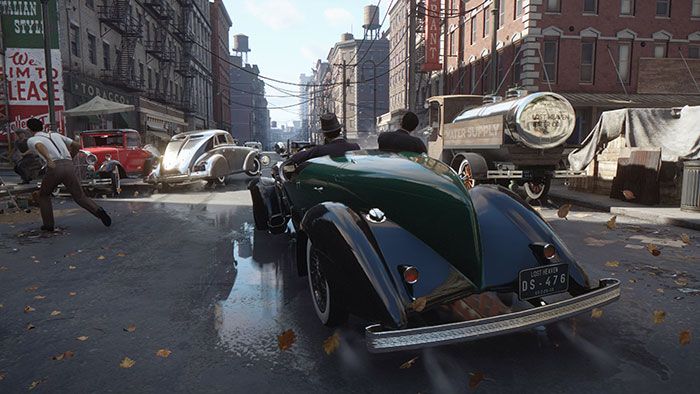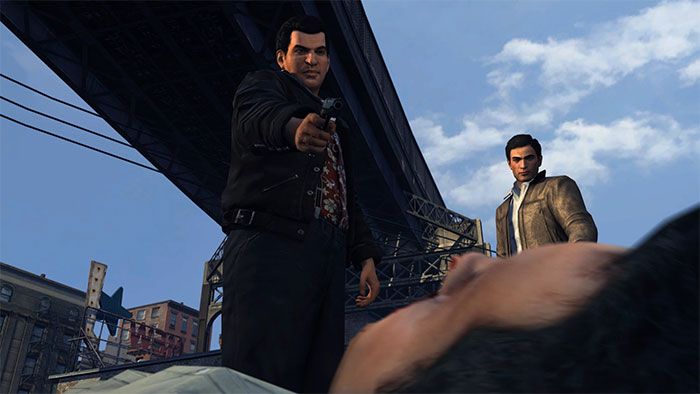Let's raise a glass to everyone who's been a part of this amazing Mafia community over the past 20 years. As of August 2022, it's been two decades since the iconic Mafia series made its debut with Mafia: The City of Lost Heaven.
It's been one hell of a ride, from the very first Mafia to Mafia II, Mafia III, and the faithful, ground-up remake of Mafia: Definitive Edition. But it hasn't been easy. Whether it was the humble beginnings of a tiny development team working on a game that initially had nothing to do with organized crime, to finding just the right way to modernize and build on the vision of the game that started it all, there have been plenty of challenges along the way.
To commemorate Mafia's 20th Anniversary, we spoke to some longtime Hangar 13 developers: General Manager Roman Hladík and Head of Production and Media Director Tomáš Hřebíček have worked on every game in the series starting with the original, while Game Director Alex Cox has been with the series since Mafia II.
Read on to hear their stories as they look back on the last 20 years of making Mafia, covering their history with the franchise and sharing some of their favorite moments—along with a special announcement about the future of the Mafia series.

Hladík, Hřebíček, and Cox show up in the games via these Wanted poster collectibles.
What role did you have when you first started working on the Mafia series, and how has it evolved in the years since?
Roman Hladík: I've been with the company—which was originally Illusion Softworks, an independent game developer in the Czech Republic—since probably the summer of '97, so I'll have been here about 25 years this year. Originally I joined the team as a 2D artist, learning a little bit of 3D, but I became a character artist on the original Mafia: The City of Lost Heaven. When we started on the original Mafia, it was just four or five people. Eventually we grew to 10 people; when we finished, it was a development team of around 20-25 people.
On Mafia II I got a chance to step up into the role of Art Director. That was probably the longest development we experienced, around eight years. We were still doing work on the console ports of the first Mafia, and we had to change Mafia II's game engine midway through the development, so it was a bit of a struggle. Mafia III was when we established the Hangar 13 team in Novato, with a couple of people from the Czech Republic moved to the US to work on it. On Mafia III, I was in charge of the team in the Czech Republic as a supporting Art Director, mostly doing art production and outsourcing.
Following Mafia III, I got a chance to become a studio head—General Manager, if you will, which is what I'm doing now. For Mafia: Definitive Edition, it was too much to do both the Art Director and General Manager work at the same time, so I asked our former colleague Petr Motejzík to join the team as the Art Director on Mafia: Definitive Edition. That said, I mostly got to keep the work on lighting and atmospheric effects to myself, which I always liked.

Tomáš Hřebíček: I started at the same time as Roman when we formed the team for the original Mafia. When we started, it was a different game concept entirely for a couple months before Daniel Vávra, the writer of the original Mafia, brought up the idea of doing a gangster game.
I started as a 3D graphic artist. I was always into visual effects; I remember being inspired and motivated to study visual effects from watching movies like Terminator 2 on VHS. I was also making amateur movies with a friend of mine back then; that's how I learned the craft of camera animation. As the Director of Photography on the original Mafia, I wanted to bring film-grade cinematography to the game.
I was also into new technology, so I convinced the team to purchase a motion capture setup—it had a magnetic field base, only covered 2x2 meters, and could only fit one actor at a time. But it was huge for us, and we got very creative; for instance, for scenes with a bunch of guys shooting at one another, we had to choreograph the whole shootout while only being able to record the actors one by one.
Towards the end of the original game I also was helping to lead the team, which led to a role as Animation Director on Mafia II and Media Director on Mafia III. After Mafia III, when Roman took over the studio here in Brno, I took the role of the Head of Production here in the Czech Republic as well as the Media Director role. For Mafia: Definitive Edition, I was with the team directing the motion capture sessions in the US and directing the final edits.

Fun fact: Hřebíček is the model for the gun-toting gangster on the cover art of the original Mafia and the silhouetted mobster in the Mafia II logo.
Alex Cox: I used to be a Producer at 2K, working with the guys on Mafia II; that was my first experience with the franchise, and my first job in Production outside of QA. I spent a lot of time working on-site with the team when 2K acquired Illusion Softworks and turned it into 2K Czech, and we became more closely involved with the development than we had been previously. I spent a lot of time with the team onsite during the development of Mafia II. I was as closely involved as I could be as an external producer, then I officially joined the team as a Designer towards the end of Mafia II and moved to the Czech Republic.
I was also a Designer on Mafia III, then became the Game Director of Mafia: Definitive Edition a couple years later. I've moved around to a lot of the studio locations: I currently work now in the Brighton studio, I worked with Roman and Tomáš over in Brno, spent a couple of years in the Prague office—so I've definitely floated around.
How does it feel to see the series build up such a devoted, global fandom in the years since the original game launched?
Hřebíček: It's been extremely rewarding. Earlier this year I was able to attend the Mafia Orchestral Concert performed by the Brno Philharmonic. Not only do they play the music—some of which they had to recreate from scratch, because the original score was lost—but they show the respective cutscenes from the games on a giant screen. When I saw the intro to the first Mafia game with all our names, I remembered the good times when I was setting up specific shots back in the day. Watching all the people in attendance enjoying it—it was so rewarding. I was so proud of our team.
Hladík: Especially in the Czech Republic, the Mafia series is such a well-known thing. There are now multiple generations who know the Mafia series, which is awesome.
Cox: As Tomáš and Roman said, it's a national institution in the Czech Republic and in surrounding countries as well, which is really interesting. I can't tell you how many times I've been over in Brno, and during the taxi ride to the studio, the driver will strike up a conversation with me about Mafia and how excited they are about the fact that Mafia is a homegrown franchise from the Czech Republic. There's a lot of national pride in the franchise.
Which game in the series is most near and dear to your heart?
Hřebíček: For me, it has to be the original Mafia. It was so enjoyable working on Definitive Edition because it brought back so many memories from 20 years ago, and we could make the game even prettier—but we were also terrified because we knew we had to do it the right way. But the original Mafia will always be so tied to the beginning of my game development career and my younger days, with all the life events, struggles, and positives that came with them.
Hladík: If I had to pick, it would be Mafia II, because that game was the one where I had the biggest impact with my work on it. Being the Art Director from beginning to the end—it was a struggle, but we made it through. I invested a lot of energy into it. So yes, for me it was probably Mafia II, although I like all of them.
Cox: Like Tomáš with the first Mafia, Mafia II was my introduction to the Mafia franchise, and it was where I really fell in love with the series and saw that core appeal. But Mafia: Definitive Edition is where I really felt the weight of responsibility, because I didn't work on the original game and I wasn't about to break the hearts of the hardcore fans of the franchise. So Mafia: Definitive Edition is our most recent achievement and I'm most proud of it, but Mafia II will always be special to me.
Which updates in Mafia: Definitive Edition felt the most impactful to you?
Cox: We tried to be quite responsible with where we changed or added things to the story. Usually we only added things to improve the pacing where things had slowed down a little bit. Overall, I think we did a good job elevating the character of Sarah, who was the only female character in the original game. She got short shrift in the original plot—she felt like a very throwaway character.
We worked quite hard to reintegrate her into the story for Definitive Edition, and there are some really touching scenes between her and Tommy, which come through not just from the revised design and the writing, but also from the execution on stage and the high-fidelity performances.
Hladík: On the original Mafia, there were a lot of technical limitations; for example, the draw distance was only a couple hundred meters, so you never got to see grandiose views of the city. With Mafia: Definitive Edition, we had this amazing opportunity to enhance the vision of the first game—suddenly we could create scenic vistas and better express the atmosphere of 1930s cities.
Cox: And this is a more dorky thing, but because Mafia: Definitive Edition was part of the Mafia: Trilogy package, it allowed us to do a little bit of a retconning, bringing the original Mafia game a bit more into the same universe as the other two titles. With the collectible cigarette cards, we presented gangsters from all three games as they would've looked in the 1930s. Being able to flesh out the backstory, unite the lore, and bring the three titles closer together was cool.
Hřebíček: It was amazing going from only being able to capture one actor 20 years ago to now being able to capture the full stage performance, including all the details of the actors' faces, which really helped the story shine. In the first game, the player's imagination had to fill in a lot of the gaps; in one scene, a mobster posing as a train attendant is waiting around and tapping his fingers with boredom, except the technology limitations meant that it was just his stiffened hand moving slightly up and down. [laughs]
For Definitive Edition, we could play with all the details, capture every bit of the performances. There's that iconic scene when Tommy comes back to Sarah after a bloody shootout, and there's very little dialogue—but we understand so much about the connection Tommy and Sarah have through the detailed expressions on their faces.
For those who don't know, Mafia: Definitive Edition has some pretty outlandish Free Ride unlockables, like a dog head and an alien outfit for Tommy, that call back to the original game's Free Ride Extreme mode. Did you have to fight to bring those goofier things back?
Cox: We didn't have to convince anyone. [laughs] Everybody wanted to do it. The original Mafia had quite a lot of Easter Eggs, and the fanbase really geeked out on trying to find and document them all. It became this kind of legendary lore among players—knowing every Easter Egg was like proof that you were a superfan of Mafia. In those days, when internet coverage of video games was less sophisticated, being able to share those secrets was like a badge of honor for Mafia fans.
A lot of the people who had worked on the first game were still at the studio and asked to bring back some of the secrets they'd done originally that the community loved. So it was great to be able to include that stuff in Definitive Edition's Free Ride mode. It's a bit of an old-school idea to put in a wacky game mode, but it wouldn't have been the same game without at least a nod towards the stuff that was in the original.
Over these past 20 years, what have been the biggest lessons you've learned about game development?
Hladík: I would say we are learning all the time. With every project we do, we learn new stuff, because things keep developing, right? In the early days of Mafia, making games was... I wouldn't say easier, but it was a small team with simpler technology and so on. Games and technology keep developing, so it's all about constant learning.
The biggest lesson came after we managed to release the original Mafia, and we thought we fully knew how to make games. We started to work on Mafia II and it was a huge challenge—the development was slow and we were constantly hitting new issues. It was a lesson for all of us who thought we had learned enough just by doing the first game. That was the biggest realization: this is never, ever going to be easy.
Hřebíček: Another important lesson for me has been: get your assets running in the game as soon as possible and try to keep them there. A lot of the time, something seems like it's almost done, but it really isn't—the last 10% is so difficult because that's when we're checking it in the game along with everything else.
Early on, I had been so focused on the cinematic feel and animations in the story cutscenes—but I learned over the years that the game itself is more important. We need to think about the game first, then support it with a great story. To the new artists in the industry out there: you are not just a graphic artist, you are a game developer. Every discipline and department should constantly take stock of what the game is actually about.
Hladík: Right. An experienced developer will understand the other fields of development, and how other departments are working and what they're building. One example that illustrates Tomáš' point: early on with the first game, we were trying to employ architects who we thought would be great for making the environment assets. And they are, but they had a hard time bypassing real-world constraints for the sake of level design. So yeah, it's really important to accept that it's not just your discipline and your assets that make up the game. You have to understand the whole thing.
Cox: Any seasoned developer will, at some point, come to the conclusion that the one mantra to project success is: keep it simple, stupid. Don't overcomplicate things; really understand what you're good at and just do that. That's something we learned with Mafia: Definitive Edition—rather than reinventing the game, rather than changing it substantially into something different, we identified what people liked about the game originally: the distinctive, cinematic crime fantasy.
And we just really, really drilled down on that and focused on the execution. How do we modernize it without changing it? How do we make it more beautiful without altering the general atmosphere of Lost Heaven? I think that was a really good emphasis for us, and as a team we're carrying that into our future titles, understanding what our core competencies are and building on them to create even better games going forward.
As a rapid-fire way to close us out: can you share your personal favorite Mafia protagonist, side character, and mission?
Hladík: Joe from Mafia II might be both my favorite side character and protagonist, if you count the Joe's Adventure DLC! [laughs] But focusing just on the protagonists, it would probably be Tommy. I also really like the side character of Thomas Burke in Mafia III. For missions, that's a difficult one; I think the farm in 'A Trip to the Country' from Mafia: Definitive Edition has a really nice atmosphere and great gameplay elements.
Hřebíček: Ugh, I was about to say the same mission; you stole mine! [laughs] There are so many great and crazy characters in Mafia III—you mentioned Burke, and I love Donovan too. For main protagonists, I would say it's pretty close between either Tommy or Vito. For side characters, let's say Paulie; I felt he was too naive in the original Mafia, but we improved his character for Mafia: Definitive Edition for sure.
Cox: My favorite protagonist is Vito; he was the first hero I fell in love with. There's great sidekicks in all the games, but I would have to say Donovan in Mafia III is my favorite side character. There's a mission in Mafia II called 'In Loving Memory of Francesco Potenza'—it's not a very gameplay-heavy mission, just the guys driving around in a car together. They're super drunk, they've just been to a brothel, and they realize they've got a dead body in the trunk that they have to go bury.
Chaos ensues, but what's really beautiful about that mission is how it shows that core of the fantasy with this trio of friends, where crime and real life intersect. I think that's the heart of the franchise, really. There's The Family, and the family—these guys are really close friends, they're blood brothers, they have to face weightier, darker subject matters in their life of crime. So getting to hear them drunkenly singing together as they drive back from burying a body in the forest is a really evocative scene for me.
Lastly, can you tell us anything about what's next for the Mafia franchise?
Hladík: I'm happy to confirm we've started work on an all-new Mafia project! While it's a few years away and we can't share anything more right now, we're really excited to keep working on this beloved franchise and to entertain our players with new stories.
Thanks very much for reading and for being a part of the Mafia community all these many years. For more developer insights, especially around the making of Mafia: Definitive Edition, check out the articles below.
- Recasting Tommy Angelo for Mafia: Definitive Edition
- The supporting cast of Mafia: Definitive Edition
- Rebuilding Lost Heaven for Mafia: Definitive Edition
- Mafia Dev Diary: Celebrating 18 years in the life
- The art of Mafia: Definitive Edition
- Maintaining authenticity in Mafia: Definitive Edition
- Crafting the sounds and score of Mafia: Definitive Edition
- Mafia: Definitive Edition story trailer, plus developer insights
- Introducing Mafia: Definitive Edition's Classic Difficulty
- Remaking Mafia: Definitive Edition's Infamous Race Mission






